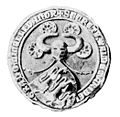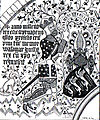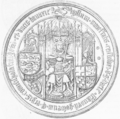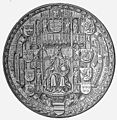Coat of arms of Denmark
| Coat of arms of Denmark | |
|---|---|
 | |
| Adopted | First documented in the 1190s. Modified 1819 |
| Crest | Crown of Christian V |
| Shield | Or, three lions passant in pale Azure crowned and armed Or langued Gules, nine hearts Gules |
The National Coat of Arms of Denmark consists of three crowned blue lions accompanied by nine red hearts, all in a golden shield. The oldest known depiction of the insignia dates from a seal used by King Canute VI c. 1194. The oldest documentation for the colours dates from c. 1270.[1] Historically, the lions faced the viewer and the number of hearts was not regulated and could be much higher. Historians believe that the hearts originally were søblade (literally: sea-leaves) but that this meaning was lost early due to worn and crudely made signets used during the Middle Ages. A royal decree of 1972 specifies these figures as søblade but Danes normally refer to them as hearts. The current version was adopted in 1819 during the reign of King Frederick VI who fixed the number of hearts to nine and decreed that the heraldic beasts were lions, consequently facing forward. A rare version exists from the reign of king Eric of Pomerania in which the three lions jointly hold the Danish banner, in a similar fashion as in the coat of arms of the former South Jutland County. Until c. 1960, Denmark used both a "small" and a "large" coat of arms, similar to the system still used in Sweden. The latter symbol held wide use within the government administration, e.g. by the Foreign Ministry. Since this time, the latter symbol has been classified as the coat of arms of the royal family, leaving Denmark with only one national coat of arms, used for all official purposes.
The crown on the shield is a heraldic construction based on the crown of King Christian V, not to be confused with the crown of King Christian IV. The main difference from the real crown is that the latter is covered with table cut diamonds rather than pearls. Both crowns, and other royal insignia, are located in Rosenborg Castle in Copenhagen.
The blazon in heraldic terms is: Or, three lions passant in pale Azure crowned and armed Or langued Gules, nine hearts Gules.




This insignia is almost identical to the coats of arms of Estonia and Tallinn which can both be traced directly back to King Valdemar II and the Danish rule in northern Estonia 1219-1346. The main differences are as follows: In the Danish coat of arms the lions are crowned, face forward, and accompanied by nine hearts. In the Estonian coat of arms, the "leopards" face the viewer, they are not crowned, and no hearts are present. The coat of arms of Tallinn resembles the Estonian arms, but the leopards in the former arms are crowned with golden crowns[3] similar to the ones in the Danish arms. It shows great similarities with the contemporary insignia of England's Richard the Lionheart and the current arms of the German state of Baden-Württemberg. The Danish coat of arms has also been the inspiration for the coat of arms of the former Duchy of Schleswig, a former Danish province (two blue lions in a golden shield.) The hearts of the coat of arms also appear in the coat of arms of the German district of Lüneburg.
Royal coat of arms
| Arms of the Danish royal family | |
|---|---|
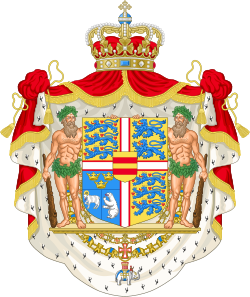 | |
| Adopted | Designed 1819. Designated as dynastic arms 1959. Last modified 5 July 1972 |
| Crest | Crown of King Christian V of Denmark |
| Torse | tasseled strings Or |
| Shield | A shield quartered by a cross Argent fimbriated Gules, first and fourth quarter Or, three lions passant in pale Azure crowned and armed Or langued Gules, nine hearts Gules (for Denmark); second quarter Or, two lions passant in pale Azure armed Or langued Gules (for Schleswig); third quarter Azure, party per fess, in base per pale; in chief three crowns Or (for the Kalmar Union), in dexter base a ram passant Argent armed and unguled Or (for the Faroe Islands), in sinister base a polar bear rampant Argent (for Greenland). Overall an escutcheon Or two bars Gules (for Oldenburg) |
| Supporters | two wild men armed with clubs Proper |
| Compartment | pedestal |
| Order(s) | Order of the Dannebrog, and Order of the Elephant |
The royal coat of arms is more complex.[4] The shield is quartered by a silver cross fimbriated in red, derived from the Danish flag, the Dannebrog. The first and fourth quarters represent Denmark by three crowned lions passant accompanied by nine hearts; the second quarter contains two lions passant representing Schleswig, a former Danish province now divided between Denmark and Germany, the third quarter contains a total of three symbols. The three golden crowns on blue are officially interpreted as a symbol of the former Kalmar Union. This symbol is identical to the coat of arms of Sweden and originally represented a Danish claim to the Swedish crown. The silver ram on blue represents the Faroe Islands and the similarly coloured polar bear represents Greenland. The current version of the arms, established by royal decree 5 July 1972[4], is greatly simplified from the previous version which contained seven additional sub-coats representing five territories formerly ruled by the Danish kings and two medieval titles: Holstein, Stormarn, Dithmarschen, Lauenburg, Delmenhorst, and King of the Wends and Goths. A crowned silver stockfish on red was formerly included to represent Iceland, but due to Icelandic opposition, this symbol was replaced in 1903 by a silver falcon on blue. The falcon was in turn removed from the royal arms in 1948 following the death of King Christian X in 1947 and reflecting the 1944 breakup of the Dano-Icelandic union.
The centre escutcheon, two red bars on a golden shield, represents Oldenburg; the ancestral home of the former royal dynasty that ruled Denmark and Norway since the middle of the fifteenth century. When the senior branch of this dynasty became extinct in 1863, the crown passed to Prince Christian of the cadet branch Glücksburg, whose descendents have reigned in Denmark ever since. The House of Glücksburg continues the use of the arms of the old Oldenburg dynasty, and the symbol is still officially referred to by its old association.
Two woodwoses (vildmænd) act as supporters, and this element can be traced back to the early reign of the Oldenburg dynasty. Similar supporters were used in the former arms of Prussia. The shield features the insignias of the Order of the Dannebrog and the Order of the Elephant around it.
The shield and supporters are framed by a royal ermine robe, surmounted by a royal crown.
A blazon in heraldic terms is: A shield quartered by a cross Argent fimbriated Gules, first and fourth quarter Or, three lions passant in pale Azure crowned and armed Or langued Gules, nine hearts Gules (for Denmark); second quarter Or, two lions passant in pale Azure armed Or langued Gules (for Schleswig); third quarter Azure, party per fess, in base per pale; in chief three crowns Or (for the Kalmar Union), in dexter base a ram passant Argent armed and unguled Or (for the Faroe Islands), in sinister base a polar bear rampant Argent (for Greenland). Overall an escutcheon Or two bars Gules (for Oldenburg) the whole surrounded by the Collars of the Order of the Dannebrog and the Order of the Elephant. Supporters two woodwoses armed with clubs Proper standing on a pedestal. All surrounded by a mantle Gules doubled Ermine crowned with a royal crown and tied up with tasseled strings Or.
The royal coat of arms has since c. 1960 been reserved exclusively for use by the Monarch, the royal family, the Royal Guards and the royal court according to royal decree. A select number of purveyors to the Danish royal family are also allowed to use the royal insignia.
Other members of the Royal Family
-
Coat of Arms of Crown Prince Frederick is similar to the Royal Coat of arms except for the heir apparent's Crown and the purple mantle.
-
Coat of Arms of Prince Henrik, the Prince Consort; the arms is quartered between the Danish Royal Arms (1st and 4th quarters) and the Arms of the Counts of de Laborde de Monpezat (2nd and 3rd quarters)- A gold lion rampant on a field of red with three five-pointed stars in the chief. The arms features two golden lions rampant as supporters. The crown is that of a Prince of Denmark.
-
Coat of Arms of Prince Joachim is similar to the Royal Coat of arms except the escutcheon, which is divided with the first being that of the House of Oldenburg and second being that of the House of de Laborde de Monpezat. The crown is that of a Prince of Denmark.
Territories and titles formerly represented in the Danish arms


The following list is based on the research by Danish heraldist, Erling Svane.[5] Danish names are shown in italics.
- Norway (Norge): 1398 - c. 1819: on red, a crowned golden lion carrying a golden axe with a silver blade. The union with Norway was dissolved in 1814 as a result of the Napoleonic Wars.
- Sweden (Sverige): 1398 - the Folkung lion, the arms of Sweden until 1364. Only used during the reign of Eric of Pomerania.
- Pomerania (Pommern): 1398 - a red griffin on silver. Only used during the reign of Eric of Pomerania.
- Bavaria (Bayern): 1440 - lozengy blue/white. Only used during the reign of Christopher of Bavaria.
- Palatinate (Pfalz): 1440 - a crowned golden lion on black. Only used during the reign of Christopher of Bavaria.
- King of the Wends (Vendernes Konge): 1440 - 1972: a crowned golden lindorm on red. Canute VI proclaimed himself Rex Sclavorum (King of Slavs). From the reign of Valdemar IV this title was known as King of the Wends. This symbol was later also interpreted as the coat of arms of Funen[6] and appeared in the official insignia of the now-defunct army regiment Fynske Livregiment. It should not be confused with the similar insignia of Bornholm, also formerly included in the Danish arms.
- King of the Goths (Gothernes Konge): 1449 - 1972: in gold, a blue lion passant over nine red hearts arranged 4, 3, 2. Originally a leopard. Derived from the arms of Denmark and originally the arms of the Dukes of Halland. The lion is almost never crowned. This symbol was later also interpreted as the coat of arms of Jutland. It appears on the stern of the 19th century frigate Jylland and in the official insignia of the army regiment Jydske Dragonregiment.
- Holstein (Holsten): 1440 - 1972: on red, a silver nettle leaf; sometimes seen as a silver shield with a red indented bordure.
- Stormarn (Stormarn): 1496 - 1972: on red, a silver swan with a golden crown around its neck.
- Delmenhorst (Delmenhorst): 1531 - 1972: on blue, a golden cross.
- Dithmarschen (Ditmarsken): 1563 - 1972: on red, a knight dressed in golden armor on a silver horse. On his arm, an oval blue shield with a golden cross. Frederick II conquered Dithmarschen in 1559.
- Iceland (Island): 16th century - 1903: on red, a crowned silver stockfish. The symbol had been associated with Iceland from the early sixteenth century. First included in the arms of Frederick II. 1903 - 1948: a silver falcon on blue. Iceland dissolved the union with Denmark in 1944, and when King Christian X died in 1947, the new King Frederick IX decided to remove the falcon from his arms. This change took place by royal decree on 6 July 1948[7].
- Gotland (Gotland / archaic: Gulland): on red, a silver Agnus Dei. First included by King Frederick II. Last used during the reign of King Frederick VI.
- Saaremaa (Øsel): from 1603, last used by King Frederick VI: on blue a black eagle. Several historians have explained this violation of the heraldic rule of tincture as the black colour being the result of an oxidation of white paint containing lead.[8]
- Fehmarn (Femern): from 1666, last used by King Frederick VI: on blue, a golden crown.
- Bornholm (Bornholm): from c. 1665, last used by King Frederick VI: on red, a golden four-legged dragon.
- Lauenburg (Lauenborg): 1819 - 1972: on red, a golden horse's head. Derived from the German Sachsenross arms which shows a silver horse on red.
Gallery
-
Seal of Valdemar II the Victorious (reigned 1202–1241).
-
Seal of Eric V Klipping (reigned 1259–1286).
-
Seal of Eric VI Menved (reigned 1286-1319). The two eagles are references to his mother, Agnes of Brandenburg.
-
Seal of Valdemar IV Atterdag (reigned 1340-1375). Early 1340s.
-
Fresco of King Valdemar IV Atterdag as king. Notice the crest on the Danish arms, Saint Peter's Church, Næstved.
-
One of the seals of Eric VII "of Pomerania", 1398. Note that the three Danish lions carry a Danish flag (top-left corner).
-
Seal of Christopher III "of Baravia", 1440s.
-
Sigilum secretum of Christian I, 1449.
-
Sigilum secretum of Christian I, 1457-1460.
-
Seal of King Hans (reigned 1481 – 1513).
-
Seal of Christian III (reigned 1534 - 1559).
-
Coat of arms of Christian III as it appeared in the first Danish-language Bible, 1550.
-
Coat of arms of Frederick II. Engraving by Jens Bircherod, 1581.
-
Eric XIV of Sweden added the Norwegian and Danish arms to the Swedish national coat of arms (the two lower quarters). This was one of the main events leading to the Northern Seven Years War
-
Coat of arms of Frederick II. 1592 engraving.
-
Coat of arms from the first issue of Kongelig allene privilegerede Tronhiems Adresse-Contoirs Efterretninger, 1767, showing the arms of Denmark, Norway and the Kalmar Union.
-
Coat of arms of Denmark used 1819 - 1903. This was the first Danish arms following the removal of the Norwegian lion.
-
Coat of arms of Denmark. Version used 1903-1948. This was the only version of the Danish arms in which Iceland was represented by a falcon rather than its traditional stockfish arms.
-
Coat of arms of Denmark. Version used 1948-1972
Related symbols

- The coat of arms of Estonia and Tallinn
- The coat of arms of Schleswig (also represented in the coat of arms of Denmark's royal family)
- The coat of arms of South Jutland County
- The coats of arms of the towns of Ribe and Varde.
- The coat of arms of the German district of Lüneburg
- The coat of arms of Schleswig-Holstein
- The coats of arms of the German town of Dannenberg and Landkreis Dannenberg
- The personal arms of Prince Philip, Duke of Edinburgh contain the arms of Denmark in the first (i.e. upper left) quarter of the shield, and the sinister (i.e. left-side) supporter is the savage from the Danish arms. He uses them on account of his descent from the Greek Schleswig-Holstein-Sonderburg-Glücksburg branch of the Danish House of Oldenburg.
References
- ^ a b Danish National Archives. "Valdemarernes våben" (in Danish). Retrieved 23 July 2007.
{{cite web}}: Check date values in:|accessdate=(help); Unknown parameter|dateformat=ignored (help) - ^ Henry Petersen (1882): Et dansk Flag fra Unionstiden i Maria-Kirken i Lübeck, Copenhagen: C.A. Reitzel, p. 26 Template:Da icon
- ^ Official website of Tallinn. "Tallinna täisvapp" (in Estonian). Retrieved 24 July 2007.
{{cite web}}: Check date values in:|accessdate=(help); Unknown parameter|dateformat=ignored (help) - ^ a b Official website of the Danish monarchy. "The Royal Coat of Arms". Retrieved 23 July 2007.
{{cite web}}: Check date values in:|accessdate=(help); Unknown parameter|dateformat=ignored (help) - ^ Svane, Erling (1994). Det danske rigsvåben og kongevåben. Odense University Press. pp. 169–179. Template:Da icon
- ^ Anders Thiset (1893). "Om danske By- og Herredsvaaben". Tidsskrift for Kunstindustri (in Danish) (10th year): page 18.
{{cite journal}}:|pages=has extra text (help) - ^ Betænkning vedrørende det danske rigsvåben (betænkning nr. 216), 1959, page 3 Template:Da icon
- ^ Svane, Erling (1994). Det danske rigsvåben og kongevåben. Odense University Press. p. 177. Template:Da icon







